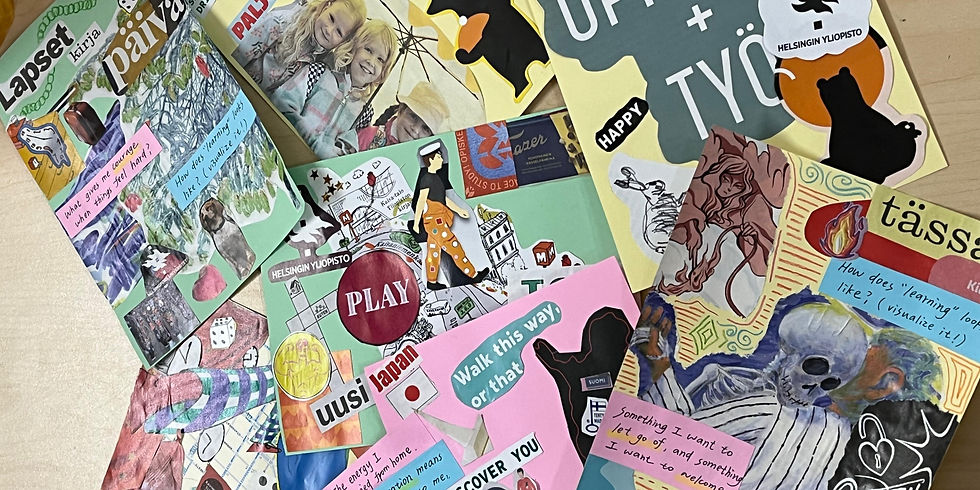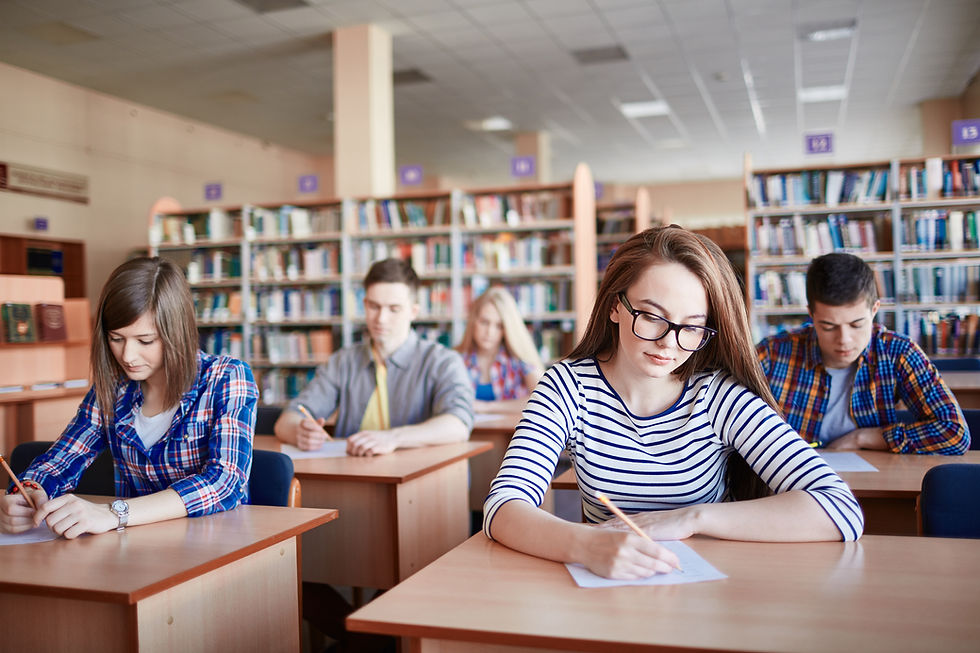The Potential of Play-Based Learning to Strengthen Teacher-Student Relationships in Adolescence
- Dippya Widiatmika, Hsin-Yi Lin, Maijuran Rajeswaran, Maria Aguar Pla
- 4 days ago
- 5 min read
Adolescence (typically ages 10 to 19) is a crucial developmental period characterized by rapid cognitive, emotional, and social growth (APA, 2018). During this stage, teenagers navigate increasing demands for independence, identity formation, and academic development. Our research explores how incorporating play-based learning (PBL) into secondary education can fundamentally transform the classroom to meet adolescents' core psychological needs and strengthen vital teacher-student relationships (TSRs).
A. The Core Problem: Unmet Psychological Needs
Adolescents thrive when their fundamental psychological needs are met. Self-Determination Theory (SDT) (Ryan & Deci, 2000) identifies three essential needs for fostering intrinsic motivation and well-being : autonomy, competence, and relatedness. When these needs are met, adolescents are more likely to engage actively in learning; when undermined, disengagement and frustration can occur.
The Three Critical Needs
Autonomy: This is the ability to make choices and control one's actions. Adolescents strive for greater independence, and environments that support autonomy, such as classrooms that allow student input, choice, and self-directed learning, enhance intrinsic motivation. Conversely, rigid curricula and controlling teaching methods that limit decision-making can hinder motivation and engagement.
Competence: This need drives adolescents to seek mastery and confidence in their abilities. Feeling capable is essential for academic success and persistence. This develops when students receive constructive feedback, appropriate challenges, and a supportive learning environment. However, unrealistic expectations or a lack of feedback can lead to frustration.
Relatedness: Adolescents are highly susceptible to social relationships. Positive connections with peers and teachers contribute to a sense of belonging, supporting academic engagement and mental health. Negative experiences, such as isolation or weak TSRs, can increase loneliness and psychological distress.
The issue is that traditional educational structures often restrict autonomy, fail to provide adequate support, and overlook social connections. This leads to disengagement, stress, and declining mental health , making it essential to create environments that empower adolescents to thrive.
B. The Solution: Strengthening Teacher-Student Relationships (TSRs)
The quality of the teacher-student relationship is a significant factor contributing to this problem. While strong TSRs foster belonging, support, and success, weak ones exacerbate disengagement and distress. Fortunately, a strong body of research demonstrates that a positive TSR can support students in coping with academic and personal demands.
The Proven Benefits of Positive TSRs
Studies consistently show that strong TSRs are associated with a variety of benefits for adolescents:
A greater sense of school belonging.
Higher academic achievement.
Increased engagement.
Enhanced well-being and greater enjoyment in school.
Greater resilience in handling challenges.
These findings underscore that positive TSRs are not merely beneficial but essential for adolescents' long-term educational success and psychological well-being.
C. The Novel Approach: Play-Based Learning in Secondary School
Play-based learning (PBL) is a learner-centered teaching approach that emphasizes students’ social and emotional development and their interests and abilities through engaging and developmentally appropriate learning experiences. While widely used in early childhood education, its application in secondary schools is less common due to various concerns among teachers.
Why PBL is a Powerful Tool for TSRs
PBL effectively addresses the needs of adolescents and strengthens TSRs by fundamentally shifting classroom dynamics:
Redefining Roles: Integrating play transforms traditional settings, redefining the roles of teachers and students. Teachers take on more flexible and dynamic roles as facilitators, fostering an interactive environment.
Vygotsky's ZPD: Vygotsky's Sociocultural Theory provides a key foundation, suggesting that play creates a Zone of Proximal Development (ZPD). Within the ZPD, teachers and peers, as more experienced individuals, support a student's learning and growth. As facilitators, teachers can scaffold students' learning, fostering deeper engagement and intellectual development.
Enhanced Closeness: Research supports this link, demonstrating that play-based learning activities significantly enhance teacher-student closeness. By actively engaging in play, teachers help students' social and emotional skills while strengthening relational bonds, creating a more trusting classroom (Driscoll and Pianta, 2010).
In essence, by integrating play into secondary education, we can reimagine the classroom as a space where learning is interactive, relational, and developmentally supportive, ensuring adolescents feel empowered, capable, and connected.
D. Proposed Intervention: Empowering Teachers
Our analysis with informed by a pilot qualitative study shows a clear gap between PBL's potential and teachers’ ability to integrate it effectively into their practice. To address this, we propose a structured intervention: professional development learning workshops (Sufi et al., 2018).
This project uses the Theory of Change (Connell & Kubisch, 1998) framework to ensure a structured and measurable approach to pedagogical transformation. The intervention links a clear process to a desired impact:
Inputs: Teachers gain foundational knowledge on PBL and its role in engagement.
Activities: Teachers participate in hands-on workshops, play-based activities, subject-specific strategy discussions, and collaborative reflections.
Outputs: Teachers identify opportunities/challenges and develop greater confidence and competence in using PBL methods.
Outcomes: Teachers implement new classroom interaction strategies, fostering stronger student engagement and collaboration.
Impact: Over time, this shift strengthens teacher-student trust, creating a more supportive and connected classroom environment.
Workshop Implementation and Assessment
The intervention consists of a three-session workshop design. The first two sessions introduce concepts and allow for subject-specific application , while the final session is dedicated to reflection and strategizing for implementation. Workshops are an effective method for professional development, providing interactive and experiential learning.
To assess the impact, we will use three complementary approaches:
Pre- and Post-Workshop Questionnaires: To evaluate teachers' knowledge and confidence in applying PBL.
Observation: To provide insights into teacher engagement and willingness to experiment with strategies during the workshops.
Student Feedback Questionnaires: To measure how the implemented PBL affects TSRs in the classroom.
We will specifically use the Bonanno et al. (2024) framework to assess TSRs, which comprehensively measures six dimensions, including Positive Teacher Qualities, Instructional Methods, and Classroom Climate . This multi-perspective evaluation ensures we capture both teacher perceptions and fundamental changes in classroom dynamics.
This project provides a structured pathway to overcoming systemic contradictions and developing the mindset, skills, and confidence necessary for teachers to transform classroom dynamics, ultimately fostering a more engaging and trusting learning environment.

Link to the workshop planning: https://helsinkifi-my.sharepoint.com/:b:/g/personal/dippya_ad_helsinki_fi/EUCeHmcrLPtDg40HRYf-75MBldZie9c9kBYnFSKe6_qk1g?e=QOwAh3
Reference:
American Psychological Association. (2018). Adolescence. In APA dictionary of psychology. Retrieved from https://dictionary.apa.org/adolescence
Artola Bonanno, A., Briesch, A. M., Lifter, K., & Kemerer, P. (2024). Measuring teacher-student relationships in adolescence: A systematic, cross-cultural review. International Journal of School and Educational Psychology, 12(2), 96–108. https://doi.org/10.1080/21683603.2024.2328834
Driscoll, K. C., & Pianta, R. C. (2010). Banking time in head start: Early efficacy of an intervention designed to promote supportive teacher–child relationships. Early Education and Development, 21(1), 38-64.
Ryan, R. M., & Deci, E. L. (2000). Self-determination theory and the facilitation of intrinsic motivation, social development, and well-being. American Psychologist, 55(1), 68–78. https://doi.org/10.1037/0003-066X.55.1.68
Sufi, S., Nenadic, A., Silva, R., Duckles, B., Simera, I., de Beyer, J. A., Struthers, C., Nurmikko-Fuller, T., Bellis, L., Miah, W., Wilde, A., Emsley, I., Philippe, O., Balzano, M., Coelho, S., Ford, H., Jones, C., & Higgins, V. (2018). Ten simple rules for measuring the impact of workshops. PLoS computational biology, 14(8), e1006191. https://doi.org/10.1371/journal.pcbi.1006191.
Taylor, M. E., & Boyer, W. (2020). Play-based learning: Evidence-based research to improve children’s learning experiences in the kindergarten classroom. Early Childhood Education Journal, 48(2), 127-133.
Wang, M.-T., & Holcombe, R. (2010). Adolescents’ perceptions of school environment, engagement, and academic achievement in middle school. American Educational Research Journal, 47(3), 633–662. https://doi.org/10.3102/0002831209361209
About the Author

The authors of this mini-study are Dippya Widiatmika, Hsin-Yi Lin, Maijuran Rajeswaran, and Maria Aguar Pla—students from the Changing Education Master’s program at the University of Helsinki. This project serves as a final assignment for the Topical Issues in Educational Research Course




Comments